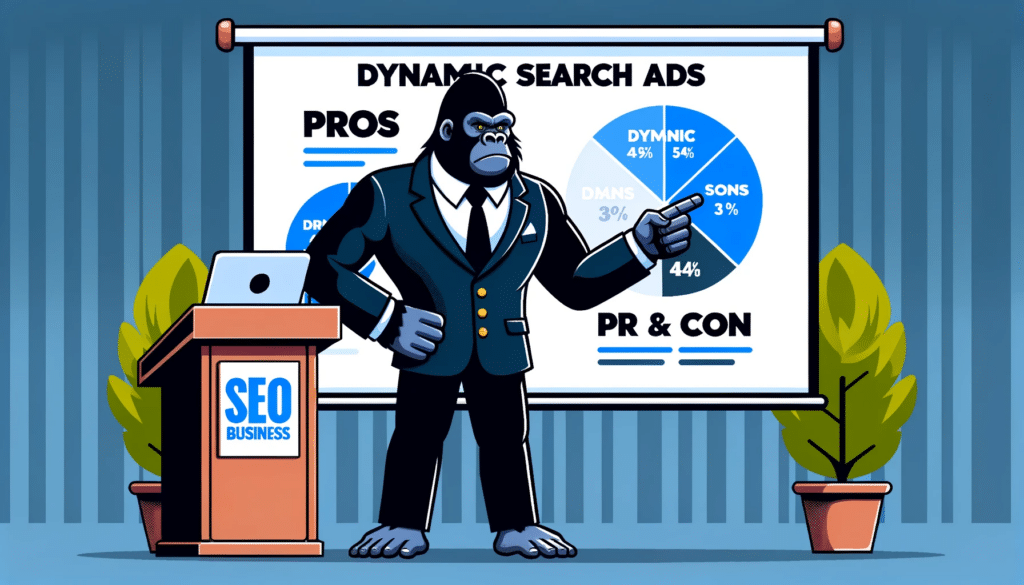My first contact with Dynamic Search ads
I still remember the day when I heard about Dynamic for the first time Search ads (DSA) heard. I was in the middle of doing some tedious keyword research for a Google Ads campaign when an old friend said to me: »Why are you doing all this manually? Have you ever heard of Dynamic Search Ads heard?« And so my journey into the fascinating world of DSA began. But enough nostalgia, now let's get down to business!
What are Dynamic? Search Ads (DSA)?
Definition and basics
Dynamic Search Ads (DSA) are an innovative ad format in Google Ads, which allows ads to be generated dynamically. Instead of keywords If you set it manually, Google will crawl your website and create ads based on the content it finds. This means that the ads are always current and relevant without you having to make constant manual adjustments.
Differences from traditional Google Ads

Unlike conventional Google Ads, where you need to specify every detail of the ad, DSA does most of the work for you. The system automatically selects the ad title, destination URL and even the ad description. This not only saves time, but also increases the relevance of the ads because they go directly to the site Content tailored to your website.
Technical functionality
DSA use a special one algorithm, which analyzes the content of your website and generates relevant advertisements. Both the text as well as the meta information of the page is taken into account. The algorithm is able to evaluate the relevance of the page for specific search queries and display ads accordingly.
Application Areas
DSA are particularly useful for:
- E-commerce websites: With many products that change regularly.
- Content portals: Where new ones all the time Article or information can be added.
- Service companies: Who offer a wide range of services and update them regularly.
Why Dynamic Search Ads?
Advantages and use cases
Automation
Once set up, DSA almost runs itself. The system will scan your Website continuously and dynamically adjusts the displays. This means less manual work for you and more time for other important tasks.
time savings
The manual one Keyword research and ad creation can be very time consuming. With DSA, this process is automated, saving you the valuable time you spend Optimizing other areas of your online marketing can invest.
Flexibility

DSA are ideal for websites with many products or frequently changing products Content. You don't have to for each new one Products or create a separate ad for each new page. The system automatically adjusts the displays to the current one Content your website.
Scalability
With DSA you can easily scale your campaigns. If your Website As your DSA campaign grows and more products or services are added, your DSA campaign will automatically grow with you. This is particularly useful for e-commerce companies or websites with a wide product portfolio.
Increase traffic and conversion
Relevance of the ads
By dynamically adapting to the Content Your website's ads are always relevant to users' search queries. This increases the likelihood that users will click on your ad and convert.
Improved target group targeting
DSA enable a very specific target group approach. By automatically adapting the ads to your content Website Reach exactly the users who are interested in your products or services.
cost
DSAs are often more cost-effective than traditional ones Google Ads. Because the ads are automatically optimized, you achieve a higher click-through rate (CTR) and a lower cost-per-click (CPC) rate.
A/B testing and optimization
With DSA, you can easily perform A/B testing to find out which ad copy and landing pages are the most effective. You can then use the results to further develop your campaign optimize.
How DSA works
Automatic generation of ads
Google crawls your website and creates ads based on the content it finds. This means that the ads are always current and relevant. Google uses an algorithm that... Content of your website analyzed and the most relevant keywords identified. These keywords are then used to generate the ad titles and descriptions.
Adaptation to the website content

DSA are particularly useful for websites whose content changes frequently. The displays adjust automatically, so you don't have to constantly make manual adjustments. If you are, among other things, an online shop and regularly new ones Products add, the DSA will be automatically updated to reflect these new products.
Dynamic destination URLs
Another interesting feature of DSA is the dynamic selection of target URLs. Google automatically chooses the most suitable subpage of your website as the target URL for the ad. This increases the likelihood that the user will end up on the page that is most relevant to them, which in turn conversion rate can increase.
Bidding strategies and budget
With DSA, you can use different bidding strategies, just like traditional ones Google Ads. You can set manual bids or use automatic bidding strategies like »Target CPA"(Cost per conversion) or "Target ROAS"(Return on advertising spend) use. The Budget for DSA can be set either as a daily budget or as a total budget for the entire campaign duration.
Exclusion criteria and negative keywords
Although DSAs are largely automated, you have the option to exclude certain pages or keywords from your campaign. This is particularly useful if you don't want ads targeted to certain, less relevant or sensitive areas of your Website be switched.
Tracking and analysis
DSA offer extensive tracking options. You can monitor the performance of your ads in real time via the Google Track Ads Dashboard. There you will find important metrics such as click rate, conversion rate and cost per click that will help you evaluate the success of your campaign and make adjustments if necessary.
Strategies for effective DSA campaigns
Choosing the right setting modes
There are different modes on how you can target your DSA campaign:
- Entire website: Ideal for websites with extensive and diverse content. All pages on your website are taken into account for ad creation.
- Specific categories: Perfect if you only want to promote specific products or services. You can select specific categories or even individual product pages for this.
- Page feed: For very specific campaigns where you want full control over the target URLs. With a page feed you can Google Tell us exactly which pages or products you want to promote.
Strategic considerations for mode selection
- Entire website: Use this mode if you have a wide range of products and the maximum Reach want to achieve.
- Specific categories: Ideal for seasonal campaigns or when you launch new products. This allows you to put the focus exactly where it is needed.
- Page feed: If you have dedicated landing pages for specific products or offers, Page Feed is your best choice.
Select specific pages or categories
You can set up your DSA campaign to focus only on specific pages or categories on your website. This is particularly useful if you want to promote special offers or promotions.
Tips for choosing

- product pages: When you launch a new product, focus the DSA on that specific product page.
- Seasonal offers: Target your DSA to categories that are particularly relevant to the current season (e.g. winter clothing in December).
Targeting ads to the page feed
A page feed allows you to tell Google exactly which pages or products you want to promote. This gives you maximum control over your DSA campaign.
How to create an effective page feed
- Product details: Add all relevant information such as product name, price and availability.
- Topicality: Always keep the feed up to date, especially when there are price changes or new products.
Bidding strategies and budget planning
The right bidding strategy can make the difference between a successful and a less successful DSA campaign.
Bid strategy options
- Automatic bidding: Let Google Automatically adjust bids to get the most clicks for your budget.
- Manual bidding: If you want more control, you can also set bids manually.
Budget planning
- test phase: Start with a smaller budget to test the performance of your DSA campaign.
- scaling: Once you have the results from the testing phase, you can adjust the budget accordingly.
Features and advantages of DSA
Cost efficiency and time saving
- Automatic bid adjustment: DSAs use Google's intelligent bidding strategies to adjust bids in real time. This maximizes your chances of getting the best ROI for your investment.
- Less time spent creating ads: Since the ads are generated dynamically, you save valuable time that you can invest in other marketing activities.
Control over the campaign

- Exclusion lists: You can exclude specific keywords or pages to ensure your ads only appear for relevant searches.
- Manual bid adjustment: Although DSAs are automated, you can still make manual adjustments to improve your campaign's performance optimize.
Scalability and adaptability
- Quickly adapt to market changes: Because DSAs are based on the current content of your website, they can quickly adapt to changes in the market or seasonal changes Trends to adjust.
- Easy scaling: As you expand your product offerings or introduce new services, your DSA updates automatically, eliminating the need to create new campaigns.
Improved target group targeting
- Relevance through dynamic adaptation: DSA automatically adapt to the content of your website, resulting in higher relevance and better targeting.
- Extended range: By using DSA, you can cover searches that you might have missed if you only did manual searches Keyword research . perform
Multilingual and international campaigns
- automatic translation: If your website is multilingual, DSA can be automatically generated in different languages.
- Local adaptation: You can set up DSA for different geographical locations, which is especially useful if you run an international business.
A/B testing and performance analysis
- Simple A/B testing: With DSA, you can easily test different ad copy and landing pages to see which ones perform best.
- Detailed performance reports: Google ads offers comprehensive analytics tools to help you track the performance of your DSA in detail.
Tips and tricks for DSA
Exclusion of certain keywords or pages
If you do not want certain pages or keywords appear in your DSA campaign, you can simply exclude them. This is particularly useful if you want to avoid showing ads to pages that are not relevant or do not convert.
Optimization of ad text
Use of ad extensions

Ad copy should be general enough to be relevant to different search queries, but also specific enough to entice users to click. Experiment with different call-to-actions and monitor them Performanceto find the best ad copy.
Ad extensions can visibility Increase your ads and provide additional information. You can use location extensions, call extensions, or even snippet extensions to make your ads more attractive.
Targeted bidding strategies
Choosing the right bidding strategy can have a big impact on the performance of your DSA campaign. Consider using an automated bidding strategy like »Target CPA" or "Target ROAS« is suitable for your goals.
Seasonal adjustments
If your business experiences seasonal fluctuations, adjust your DSA campaign accordingly. Increase bids during peak seasons and reduce them during less active months.
monitoring and adjustment
While DSAs are largely automated, that doesn't mean you should ignore them completely. Monitor performance regularly and make adjustments as necessary. This may include excluding certain keywords or adjusting bids.
Using dynamic keyword insertion
Dynamic keyword insertion can increase the relevance of your ads by automatically adapting the ad text to the user's search query. But be careful: excessive use can lead to inappropriate or even misleading ads.
Pitfalls and Challenges
Automatic selection of the target URL
A common pitfall with DSA is the automatic selection of the target URL Google. Sometimes chooses Google does not display the optimal page, which can lead to a lower conversion rate. Make sure you regularly check the performance of your ads and make adjustments if necessary.
Competition with other campaigns
DSA can work with your others Google Ads campaigns compete when they are optimized for the same keywords. Therefore, be careful to avoid overlaps so as not to end up in a bidding war with yourself.
Inadequate ad customization

While automation is a huge benefit of DSA, it can also result in generic or irrelevant ads. It's important to craft ad copy and descriptions so that they're relevant to a wide range of search queries without becoming too general.
Lack of control over keywords
DSAs generate ads based on your website's content, which means you have less control over the keywords your ads appear for. This can lead to unwanted clicks and higher costs if not carefully monitored.
Budget overrun
Automating DSA can cause your budget to be used up faster than expected, especially if the ads are shown for highly competitive keywords. It is advisable to keep an eye on your budget and make adjustments if necessary.
Legal risks
Depending on the industry and type of content being promoted, automatic ad generation can lead to legal issues. Make sure all automatically generated ads comply with legal requirements.
Lack of transparency
Another disadvantage of automation is the lack of transparency. It can be difficult to understand exactly how Google the ads are generated and for which search queries they are displayed. This requires careful monitoring and possibly manual adjustments.
Conclusion and outlook
DSA are a powerful one Tools in the world of online marketing. They offer a range of benefits, from automation to cost-effectiveness, but they are not without their pitfalls. With the right one Strategy and a little know-how, however, they can be a valuable addition to your marketing mix.





